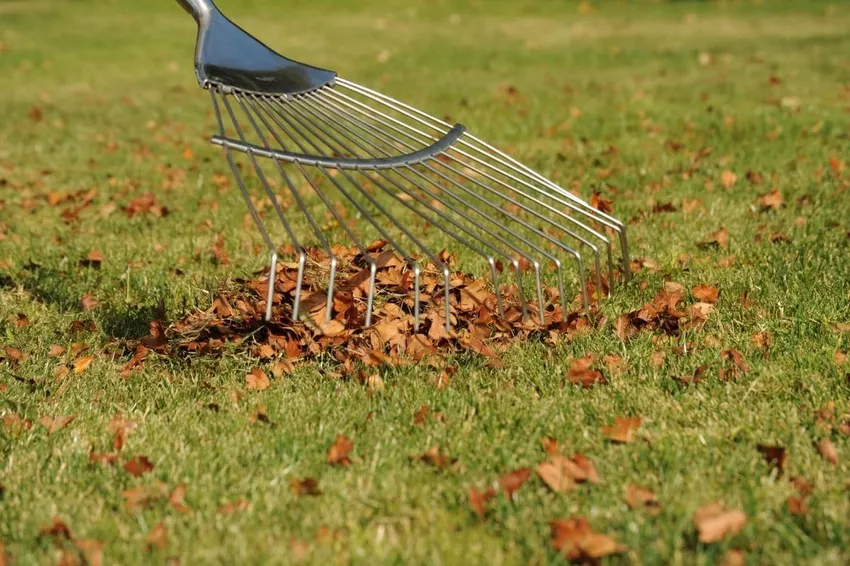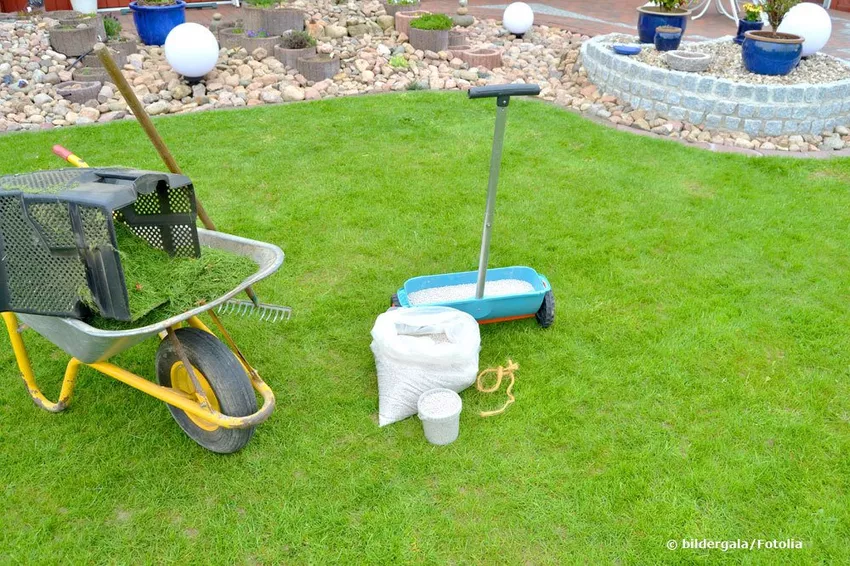
In order to make the lawn winter-proof for the cold season, good preparation of the area is extremely important. With the following steps, the lawn can survive even frosty minus degrees unscathed.
In a nutshell
- Prepare and winterize your lawn in late fall
- remove old foliage and shadow-casting objects first
- then mow to a height of 4-5 cm
- then scarify extensively and enrich with fertilizer
- Finally, close any gaps in the lawn
Remove fall leaves
No autumn leaves should be left on the lawn during the winter months. Withered leaves steal the meager light from the grass plants and cut off the oxygen supply. As a result, individual areas can turn yellow or brown, and in extreme cases the grasses even die. In addition, the decaying leaves provide constant moisture, which in combination with cool weather conditions can lead to diseases. Set up garden benches, porch swings, trampolines and other objects must also be removed from the lawn. Because these objects cast a clear shadow, they often cause lawn damage. The more sun and light the grass gets, the better it will survive the winter.
 Regular raking of leaves prevents fungal infections.
Regular raking of leaves prevents fungal infections.
- Rotting leaves promote mold diseases
- Reduced sunlight encourages moss growth
- Remove leaf debris from the lawn every week
- Proceed carefully with fan broom or rake
- Avoid injuries in the turf
- Compost leaves in wire mesh baskets
Mow last time
The lawn has to withstand a lot of stress during the harsh winter months. These include prolonged rainfall, dense snow cover and frosty temperatures that bother her. To ensure that the grass looks presentable again next spring, preparing for winter includes mowing one last time. The right time is crucial so that the lawn can recover sufficiently before the first ground frosts. Cutting the lawn too late can cause severe frost damage. When the lawn is shorter in the cold season, it remains stronger and more resilient. However, the cutting height must not be too short, otherwise the grass will only perform its protective function in relation to the ground to a limited extent. This allows frost to penetrate the soil more easily, leading to damage in the root area.

- Carry out the last lawn cut of the year in October
- Mow a little later on very warm autumn days
- Depending on the weather, early to mid-November at the latest is possible
- Straws that are too long break off in frost and under snow loads
- After that, the grass rots and begins to mold
- The ideal cutting height is 4 to 5 cm
- Be sure to remove grass clippings, they must not be left lying around
- Otherwise there will be too much moisture underneath
Notice: As a rule, grasses stop growing at temperatures below 8° to 10° Celsius.
scarify
In order to make the lawn thoroughly winter-proof, it must be well aerated again. In this way, a large part of the rampant moss and annoying weeds can be removed. Due to the scarifying, the lawn can dry much faster in the rainy winter months. The more intensively the lawn surface is prepared, the healthier the grass will survive the cold season.
- Lawn needs a lot of air to circulate
- Therefore scarify again in autumn
- Edit only the top layer
- Never set the scarifier too deep
- Knives should reach about 3mm into the ground
- Do not damage the turf and lawn roots
 scarify the lawn
scarify the lawn
Fertilize
During the cold winter months, the grass takes a longer break from growth. Therefore, it makes no sense to provide the grass plants with a nitrogen-rich fertilizer. Nevertheless, a last fertilization is necessary before the onset of winter in order to provide the lawn with important nutrients and to make it winter-proof. In contrast to the growing season in spring and summer, the lawn now needs other components that act as winter protection. In this way, the grasses no longer grow as long in length, but rather develop short and strong stalks.
- Fertilize in autumn during the last warm days
- Special autumn fertilizer is ideal for this
- Contains significantly more potassium and less nitrogen
- This increases the salt content in the cell sap of the blades of grass
- Acts like antifreeze because the freezing point of the cell sap drops
- The risk of frost damage is sustainably reduced
- Apply fertilizer evenly and without gaps
- Spreading by hand is possible
- Dosing can be carried out more precisely with fertilizer wagons
- Always follow the manufacturer's instructions
 A spreader helps with even fertilization.
A spreader helps with even fertilization.
Tip: If certain areas were overlooked when fertilizing in autumn, they can be recognized immediately next spring by their brown color.
Close gaps
Now for the final step, winterizing the lawn. After the summer heat, the lawn often has bare patches at the beginning of autumn. If the soil is still sufficiently warm, unsightly gaps can be closed by overseeding. In addition, the gardener can forestall the spreading of weeds. On the other hand, if you sow the lawn too late at the end of autumn or in winter, there is little chance of the grass germinating successfully. If the seed does sprout, it happens very unevenly. Then the later growing grass plants do not correspond to the desired appearance and the composition does not appear harmonious.

- Use special mixture for overseeding
- Seeds are covered with a nutrient coat
- Get a direct growth benefit
- Are heavier, fall better between existing blades of grass
- Wind doesn't blow away grass seed as quickly
- This improves the prospect of an even result
- First slightly loosen the soil in the affected areas
- Then sow about 15 to 30 g of overseed per square meter
- Press firmly and water regularly
frequently asked Questions
How can you make grass plants even more robust for the winter?The autumn fertilizer can even be applied twice so that the lawn is completely winter-proof. In this context, the first application of fertilizer takes place at the beginning of October. The second follows about four weeks later, but no later than mid-November.
Why are normal grass seeds not suitable for overseeding?Although special reseeding mixtures are significantly more expensive than normal grass seed, the investment is worth it. The seeds have a direct boost of nutrients and grow much faster. Also, because of the nutrient envelope, birds do not recognize the seeds as conventional grains and do not eat them. The lawn shines in a flawless shade of green before the onset of winter and is completely winterproof.
How to get the lawn in shape before winter?In order for the lawn to look neat even in winter, the gardener should prepare the lawn edge with an edge trimmer. Thanks to this cutting off, the grass plants do not grow into the neighboring beds in milder temperatures.